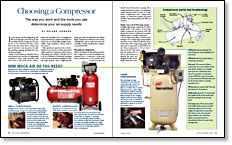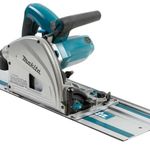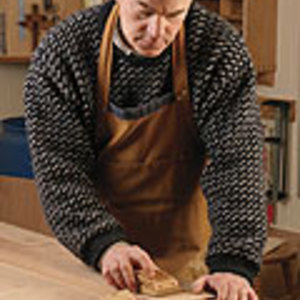All About Air Compressors

It’s hard to overstate just how useful an air compressor can be in a woodshop. Compressors not only power a wide range of tools — everything from nail guns to spray guns and sanders — but they also clean off dusty tools and people.
What Counts:
• Tank capacity and power of motor
• One- or two-stage pump
• Oil or oil-free design
• Overall size and weight for portability
Big shops that routinely run air-hungry pneumatic tools need large-capacity compressors, but many smaller shops can get by handily with a portable and less expensive machine.
Compressors are sorted roughly by the size of their tank (or tanks). Along with the power of the motor, this helps determine what kinds of tools the compressor can run. Pneumatic nail guns, even framing guns, can operate on the air supplied by a relatively small machine. Other tools, notably spray guns and sanders, need a lot more air and may overtax a compressor that’s too small. So one of the first steps in choosing a compressor is figuring out exactly what kinds of tools you’ll be using and checking to see what air supply they require.
Some models must be lubricated with oil while others are oil-free designs, which reduces maintenance. Most compressors sold these days are oil-less, and manufacturers say they should last about as long as oil-lubricated models. But they are noisier. Another factor is whether the compressor has a one- or two-stage pump. In general, two-stage pumps are preferable: they deliver higher pressures with less horsepower. They also are not as noisy and run cooler, which means less condensation inside the tank.
Portable compressors are limited
Small machines have one or two tanks and a capacity of between 4 gal. and 6 gal. of air. That’s enough for nail guns, but not enough to run a pneumatic sander or a spray gun. These compressors may be of the twin “hot dog” tank or single-tank “pancake” variety, and while not exactly light they are small enough to move around the shop or between the shop and the house or job site fairly easily. Motors run on 115-volt current. A typical machine in this class would deliver a bit over 5 cubic feet per minute (cfm) of air at 90 pounds per square inch (psi). Costs range up to about $300.
Bigger compressors get more done
Mid-sized machines have tanks of about 25 gal., giving them more reserves to run tools that require a lot of air. Tanks may be vertical or horizontal and are often on a pair of rubber wheels, making them easy to move around the shop. With the extra tank size, these compressors could run more types of pneumatic tools, but would have to operate continuously to run most pneumatic sanders, and not all motors are designed to handle that kind of wear. If the compressor would have to run more than 50 percent of the time, consider buying a larger model. Costs for midsize machines start at about $300 and go up to about $500.
These workhorses must stay put
Compressors with 60-gal. tanks can handle just about any kind of tool found in a small woodshop, including sanders and spray guns. These are larger, non-portable machines weighing a couple of hundred pounds. They typically run on 230-volt current and some have continuous-duty motors, meaning they are designed to operate 100 percent of the time without damage. Some models deliver more than 17 cfm of air at 90 psi. Costs range from about $450 to nearly $2,000.
Fine Woodworking Recommended Products

Craftsman Random Orbit Sander

Ridgid EB4424 Oscillating Spindle/Belt Sander

Makita SP6000J1 Track Saw






















Log in or create an account to post a comment.
Sign up Log in